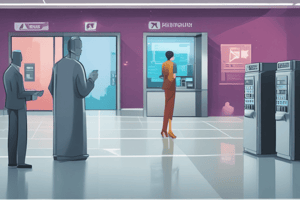Podcast
Questions and Answers
The Access Control Policy is designed to protect physical assets and sensitive information.
The Access Control Policy is designed to protect physical assets and sensitive information.
True (A)
The Access Control Policy is only applicable to systems and assets owned by the organization.
The Access Control Policy is only applicable to systems and assets owned by the organization.
False (B)
The HR role/line manager is responsible for informing IT about new employees, changes to access rights, and leavers.
The HR role/line manager is responsible for informing IT about new employees, changes to access rights, and leavers.
True (A)
The Information Security Manager approves access requests and audits user and access lists monthly.
The Information Security Manager approves access requests and audits user and access lists monthly.
Systems Administrators are not required to adhere to the Access Control Policy when making changes to access privileges.
Systems Administrators are not required to adhere to the Access Control Policy when making changes to access privileges.
User authentication is based on job classification and function.
User authentication is based on job classification and function.
Non-authenticated or shared user IDs are allowed.
Non-authenticated or shared user IDs are allowed.
Each user must have a unique user ID and personal secret password for system and network access.
Each user must have a unique user ID and personal secret password for system and network access.
Two-factor authentication is not required for remote access and network device access.
Two-factor authentication is not required for remote access and network device access.
Study Notes
Access Control Policy Summary
- The Access Control Policy is designed to minimize risks and protect physical assets and sensitive information.
- The policy is created to meet specific requirements of the Payment Card Industry Data Security Standard (PCI DSS).
- The policy applies to all systems and assets owned, managed, or operated by the organization.
- The HR role/line manager informs IT about new employees, changes to access rights, and leavers.
- The Information Security Manager approves access requests and audits user and access lists quarterly.
- Systems Administrators adhere to the policy when making changes to access privileges and ensure system configurations are enforced.
- User authentication is based on business needs, with privileges assigned based on job classification and function.
- Non-authenticated or shared user IDs are prohibited.
- Each user must have a unique user ID and personal secret password for system and network access.
- Authentication mechanisms must be appropriate for the delivery channel.
- Secure mechanisms for authentication are required for operating system access and web applications.
- Two-factor authentication must be used for remote access and network device access.
Studying That Suits You
Use AI to generate personalized quizzes and flashcards to suit your learning preferences.




